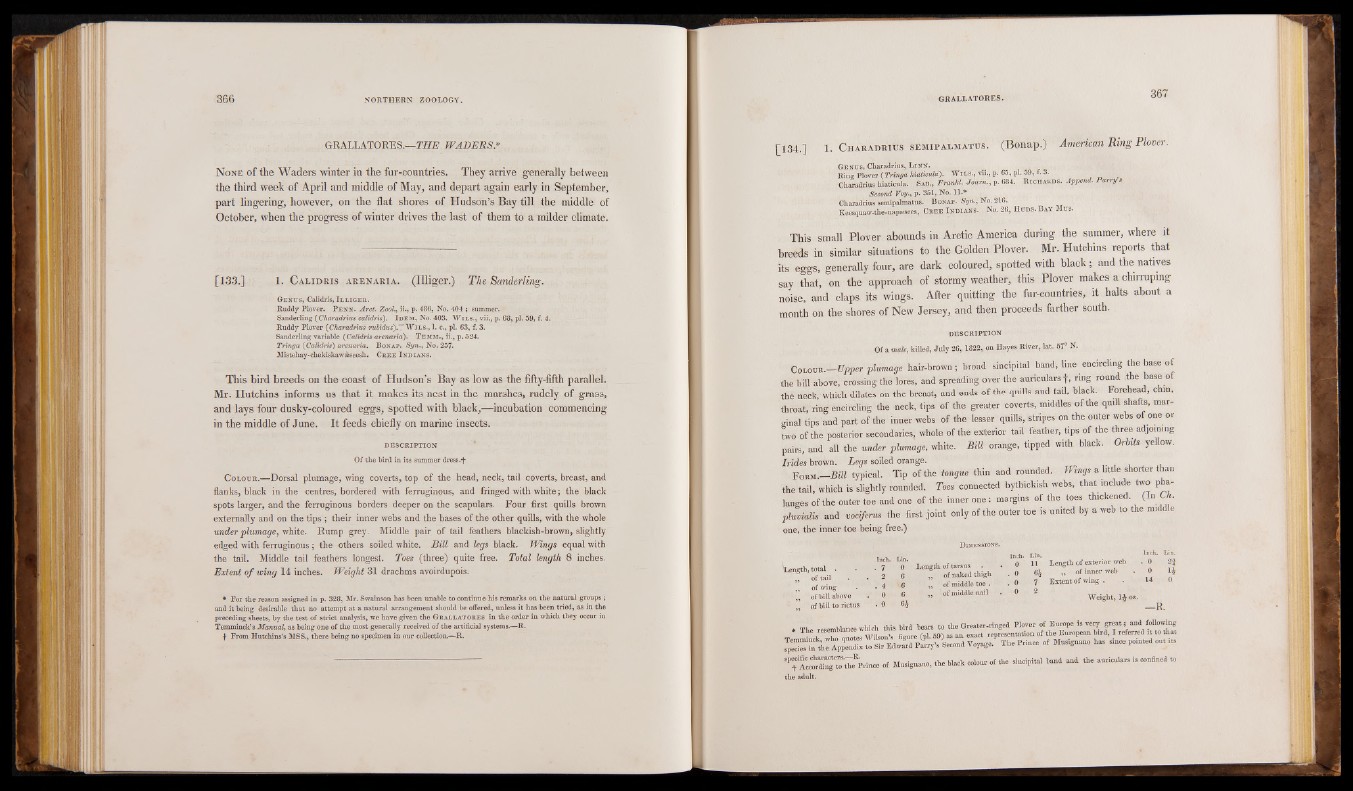
GRALLATORES.—THA WADERS*
None of the Waders winter in the fur-countries. They arrive generally between
the third week of April and middle of May, and depart again early in September,
part lingering, however, on the flat shores of Hudson’s Bay till the middle of
October, when the progress of winter drives the last of them to a milder climate.
[133.] 1. C a l id r is a r e n a r ia . (Illiger.) The Sanderling.
Genus, Calidris, Illiger.
Ruddy Plover. P enn. Arct. Zool., ii., p. 486, No. 404 ; summer.
Sanderling (Charadrius calidris). I d em , No. 403. W il s ., vii., p. 68, pi. 59, f. 4.
Ruddy Plover (Charadrius rubidus).T W il s ., 1. c., pi. 63, f. 3.
Sanderling variable (Calidris arenaria). Temm., ii., p. 524.
Tringa (Calidris) arenaria. B onap. Syn., No. 257-
Mistehay-chekiskawsfeseesh. Cr e e I n d ia n s.
This bird breeds on the coast of Hudson’s Bay as low as the fifty-fifth parallel.
Mr. Hutchins informs us that it makes its nest in the marshes, rudely of grass,
and lays four dusky-coloured eggs, spotted with black,—incubation commencing
in the middle of June. It feeds chiefly on marine insects.
DESCRIPTION
Of the bird in its summer dress.*|*
Colour.—Dorsal plumage, wing coverts, top of the head, neck, tail coverts, breast, and
flanks, black in the centres, bordered with ferruginous, and fringed with white; the black
spots larger, and the ferruginous borders deeper on the scapulars. Four first quills brown
externally and on the tips ; their inner webs and the bases of the other quills, with the whole
under plumage, white. Rump grey. Middle pair of tail feathers blackish-brown, slightly
edged with ferruginous; the others soiled white. Bill and legs black. Wings equal with
the tail. Middle tail feathers longest. Toes (three) quite free. Total length 8 inches.
Extent of wing 14 inches. Weight 31 drachms avoirdupois.
* For the reason assigned in p. 328, Mr. Swainson has been unable to continue his remarks on the natural groups ;
and it being desirable that no attempt at a natural arrangement should be offered, unless it has been tried, as in the
preceding sheets, by the test of strict analysis, we have given the Gr a l la to r e s in the order in which they occur in
Temminck’s Manual, as being one of the most generally received of the artificial systems.—R.
f From Hutchins’s MSS., there being no specimen in our collection/—R.
[134.] 1. C h a r a d r iu s s e m ip a l m a t u s . (Bonap.) American R ing Plover.
Ge n u s , Charadrius, L in n .
Ring Plover (Tringa Maticula). W il s ., vii., p. 65, pi. 59, f. 3.
Charadrius hiaticula. Sab., FrmH. Jium.., p. 684. R ic h a m js . Append. Parry s
Second Voy., p. 351, No. 11.*
Charadrius semipalmatus. B onap. Syn., No. 216.
Keesquaw-the-napsesees, Cr e e I n d ia n s . No. 26, H u ds. B ay Mu s.
This small Plover abounds in Arctic America during the summer, where it
breeds in similar situations to the Golden Plover. Mr. Hutchins reports that
its eggs, generally four, are dark coloured, spotted with black; and the natives
say that, on the approach of stormy weather, this Plover makes a chirruping
noise, and claps its wings. After quitting the fur-countries, it halts about a
month on the shores of New Jersey, and then proceeds farther south.
DESCRIPTION
Of a male, killed, July 26, 1822, on Hayes River, lat. 57°
Colour.—Upper plumage hair-brown; broad sincipital band, line encircling the base of
the bill above, crossing the lores, and spreading over the auricnlars f, ring round the base of
the neck, which dilates on the breast, and ends of the quills and tail, black. Forehead, chin,
throat, ring encircling the neck, tips of the greater coverts, middles of the quill shafts, marginal
tips and part of the inner webs of the’ lesser quills, stripes on the outer webs of one or
two of the posterior secondaries, whole of the exterior tail feather, tips of the three adjoining
pairs, and all the under plumage, white. Bill orange, tipped with black. Orbits yellow.
Irides brown. Legs soiled orange. F orm.—Bill typical. Tip of the tongue thin and rounded. Wings a little shorter than
the tail, which is slightly rounded. Toes connected bythickish webs, that include two phalanges
of the outer toe and one of the inner one: margins of the toes thickened. (In CA.
plmialis and vodferus the first joint only of the outer toe is united by a web to the midd e
one, the inner toe being free.)
Length, total .
„ of tail .
ƒ of tying é
„ of bill above
■ „ of bill to rictus
Dimensions.
Incl
. 7 0 Length of tarsus 0
6 „ of naked thigh . 0
. 4 '6 „ of middle toe . . 0
0 . 0
6
6*
■ ,, of middle nail 0
tjn Inch. Lin.
11 Length of exterior web . 0 2 f
01 , of inner web . 0 1J
7 Extent of w ing-. . 14 0 2 I Weight, 1-J oz. —R.
.. . . . l i l Hid t.pars to the Greater-ringed Plover of Europe * The resemblance w ^ h th b representation of the Europise avne rbyi rdg,r eI arte;f earnredd fiot ltloow thinagt
0» * - * — >“ - c e pointed ouH.s
SP; l t c “ To'toPnnce of Musigm.no, the black colour of the sincipital band and the auricnlars is confined to